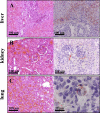The OmpA-like protein Loa22 is essential for leptospiral virulence
- PMID: 17630832
- PMCID: PMC1914066
- DOI: 10.1371/journal.ppat.0030097
The OmpA-like protein Loa22 is essential for leptospiral virulence
Abstract
Pathogenic mechanisms of Leptospira interrogans, the causal agent of leptospirosis, remain largely unknown. This is mainly due to the lack of tools for genetic manipulations of pathogenic species. In this study, we characterized a mutant obtained by insertion of the transposon Himar1 into a gene encoding a putative lipoprotein, Loa22, which has a predicted OmpA domain based on sequence identity. The resulting mutant did not express Loa22 and was attenuated in virulence in the guinea pig and hamster models of leptospirosis, whereas the genetically complemented strain was restored in Loa22 expression and virulence. Our results show that Loa22 was expressed during host infection and exposed on the cell surface. Loa22 is therefore necessary for virulence of L. interrogans in the animal model and represents, to our knowledge, the first genetically defined virulence factor in Leptospira species.
Conflict of interest statement
Figures






Similar articles
-
High-Throughput Parallel Sequencing to Measure Fitness of Leptospira interrogans Transposon Insertion Mutants during Acute Infection.PLoS Negl Trop Dis. 2016 Nov 8;10(11):e0005117. doi: 10.1371/journal.pntd.0005117. eCollection 2016 Nov. PLoS Negl Trop Dis. 2016. PMID: 27824878 Free PMC article.
-
OmpA-like protein Loa22 from Leptospira interrogans serovar Lai is cytotoxic to cultured rat renal cells and promotes inflammatory responses.Acta Biochim Biophys Sin (Shanghai). 2010 Jan;42(1):70-9. doi: 10.1093/abbs/gmp109. Acta Biochim Biophys Sin (Shanghai). 2010. PMID: 20043049
-
LipL46 is a novel surface-exposed lipoprotein expressed during leptospiral dissemination in the mammalian host.Microbiology (Reading). 2006 Dec;152(Pt 12):3777-3786. doi: 10.1099/mic.0.29162-0. Microbiology (Reading). 2006. PMID: 17159228 Free PMC article.
-
Pathogenesis of leptospirosis: the influence of genomics.Vet Microbiol. 2011 Nov 21;153(1-2):73-81. doi: 10.1016/j.vetmic.2011.02.055. Epub 2011 Mar 5. Vet Microbiol. 2011. PMID: 21440384 Review.
-
AAA+ Molecular Chaperone ClpB in Leptospira interrogans: Its Role and Significance in Leptospiral Virulence and Pathogenesis of Leptospirosis.Int J Mol Sci. 2020 Sep 11;21(18):6645. doi: 10.3390/ijms21186645. Int J Mol Sci. 2020. PMID: 32932775 Free PMC article. Review.
Cited by
-
Expression of sialic acids and other nonulosonic acids in Leptospira.BMC Microbiol. 2012 Aug 1;12:161. doi: 10.1186/1471-2180-12-161. BMC Microbiol. 2012. PMID: 22853805 Free PMC article.
-
Comparative genomic analyses of transport proteins encoded within the genomes of Leptospira species.Microb Pathog. 2015 Nov;88:52-64. doi: 10.1016/j.micpath.2015.07.019. Epub 2015 Aug 3. Microb Pathog. 2015. PMID: 26247102 Free PMC article.
-
Sex Matters: Male Hamsters Are More Susceptible to Lethal Infection with Lower Doses of Pathogenic Leptospira than Female Hamsters.Infect Immun. 2018 Sep 21;86(10):e00369-18. doi: 10.1128/IAI.00369-18. Print 2018 Oct. Infect Immun. 2018. PMID: 30012637 Free PMC article.
-
A putative regulatory genetic locus modulates virulence in the pathogen Leptospira interrogans.Infect Immun. 2014 Jun;82(6):2542-52. doi: 10.1128/IAI.01803-14. Epub 2014 Mar 31. Infect Immun. 2014. PMID: 24686063 Free PMC article.
-
Major surface protein LipL32 is not required for either acute or chronic infection with Leptospira interrogans.Infect Immun. 2009 Mar;77(3):952-8. doi: 10.1128/IAI.01370-08. Epub 2008 Dec 22. Infect Immun. 2009. PMID: 19103763 Free PMC article.
References
-
- McBride AJ, Athanazio DA, Reis MG, Ko AI. Leptospirosis. Curr Opin Infect Dis. 2005;18:376–386. - PubMed
-
- Bharti AR, Nally JE, Ricaldi JN, Matthias MA, Diaz MM, et al. Leptospirosis: A zoonotic disease of global importance. Lancet Infect Dis. 2003;3:757–771. - PubMed
-
- WHO. Leptospirosis worldwide, 1999. Weekly Epidemiol Rec. 1999;74:237–242. - PubMed
Publication types
MeSH terms
Substances
Associated data
- Actions
- Actions
- Actions
- Actions
Grants and funding
LinkOut - more resources
Full Text Sources
Other Literature Sources

